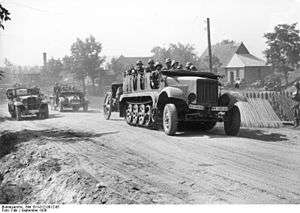SdKfz 6
| SdKfz 6 (Sonderkraftfahrzeug 6) | |
|---|---|
 SdKfz 6/1 towing 10.5 cm leFH 18 howitzer, Poland, 1939 | |
| Type | Half-track |
| Place of origin | Nazi Germany |
| Service history | |
| In service | 1939–1945 |
| Production history | |
| Designer | Büssing-NAG |
| Designed | 1934–1939 |
| Manufacturer | Büssing-NAG, Daimler-Benz, Praga |
| Unit cost | 30,000 RM |
| Produced | 1939–1944 |
| No. built | 3,500 |
| Specifications ([1]) | |
| Weight | 8,500 kg (18,700 lb) |
| Length | 6.325 m (20.75 ft) |
| Width | 2.2 m (7.2 ft) |
| Height | 2.48 m (8.1 ft) |
| Crew | 12/15 |
|
| |
| Engine |
Maybach NL 54 115 hp (86 kW) |
| Power/weight | 12.8 hp/tonne |
| Suspension | torsion bar suspension |
| Ground clearance | 40 cm (16 in) |
Operational range |
316 km (316,000 m) (road) 158 km (158,000 m) (off-road) |
| Speed | 50 km/h (road) |
The SdKfz 6 (Sonderkraftfahrzeug 6) was a half-track military vehicle used by the German Wehrmacht during the Second World War. It was designed to be used as the main towing vehicle for the 10.5 cm leFH 18 howitzer.
Development
Development of a new medium artillery tractor began in 1934 at Büssing-NAG, in Berlin. The vehicle, produced in around 750 units until 1942, could carry up to 11 men in three rows, covered by a canvas structure. Along as a tractor for the 10.5 leFH 18 howitzer, the vehicle was to be used to tow heavy equipment for engineer units. Production was carried out by both Büssing-NAG and Daimler-Benz.[1][2]
Description
The engine had a power from 90–100 hp (67–75 kW), depending from the production version. SdKfz 6 was used by the various German military forces (Wehrmacht, SS, Luftwaffe) for the entire World War II.[1][2]
Variants
- SdKfz 6/1: Standard half-tracked vehicle, used for towing various artillery pieces and transporting anything up to fifteen people.[1][3]
- 37 mm FlaK36 auf Fahrgestell Zugkraftwagen 5t (SdKfz 6/2): SdKfz 6 fitted with a 3.7 cm FlaK 36 gun, sides would fold down to allow space to work on. Crew of seven.[1][3]
- 7.62 cm FK36(r) auf Panzerjäger Selbstfahrlafette Zugkraftwagen 5t (SdKfz 6/3). SdKfz 6 fitted with a captured Soviet 76-mm divisional gun model 1936 (F-22) in an armoured superstructure.[1][3]
Sources
Bibliography
- Bishop, Chris, ed. (1998). The Encyclopedia of Weapons of World War II. Aerospace Publishing.
External links
- SdKfz 6 gallery
- "Tractors Haul Artillery In Mechanized Army" Popular Mechanics, August 1937 – excellent photo of early SdKfz 6s on parade
- Technical data of SdKfz 6
| Wikimedia Commons has media related to Sonderkraftfahrzeug 6. |